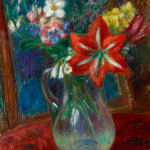William Glackens 1870-1938
50.8 x 38.1 cm
Framed dims 25 1/2 x 20 1/2 inches
Glackens’ sheer love for this subject and his joy at depicting it are clearly evident in this floral still life. He preferred natural compositions; rather than carefully arranging the flowers, he allowed them to fall into place, believing that “the day after a bouquet was put in a vase, the flowers essentially arranged themselves.” As with his larger and more complex works, these paintings often held personal meaning. For instance, the flowers frequently came from neighboring gardens and the containers were favored objects that the family owned.
Glackens' floral paintings are extraordinary in their richness and vibrancy, and they received positive critical acclaim during his lifetime. In 1936, Glackens received the Allegheny Garden Club prize at the Carnegie International exhibition for a flower piece. In 1939, only a year after the artist's death, the assistant director of the Carnegie Institute recalled this award, remarking that "this honor was appropriate for his particular gift; no artist ever more deserved this recognition of his flower paintings. Forbes Watson has well noted that few artists of any period painted flowers more in the spirit in which the earth made them. He captured the essential qualities of the flowers and made them live perpetually enveloped in his luminous colors."
Provenance
[With] Fairfield Gallery, by 1964;
Hirschl & Adler Galleries, New York, New York, acquired from above, 1964;
[With] Main Street Gallery, Chicago, Illinois, 1965;
Dr. John J. Ireland, Chicago, Illinois, acquired from above, ca. 1965–68;
The Art Institute of Chicago, Illinois, by bequest from above, 1968;
Menconi + Schoelkopf, New York, New York;
Questroyal Fine Art, New York;
Private collection, Pennsylvania until present
Exhibitions
American Embassy, Oslo, Norway, Art for Embassies Program, July 1985–September 1989Literature
Art for Embassies Program: American Embassy, Oslo, Norway (Washington, DC: Art for Embassies, 1985),
20–21.
Please join our mailing list
* denotes required fields
We will process the personal data you have supplied in accordance with our privacy policy (available on request). You can unsubscribe or change your preferences at any time by clicking the link in our emails.



